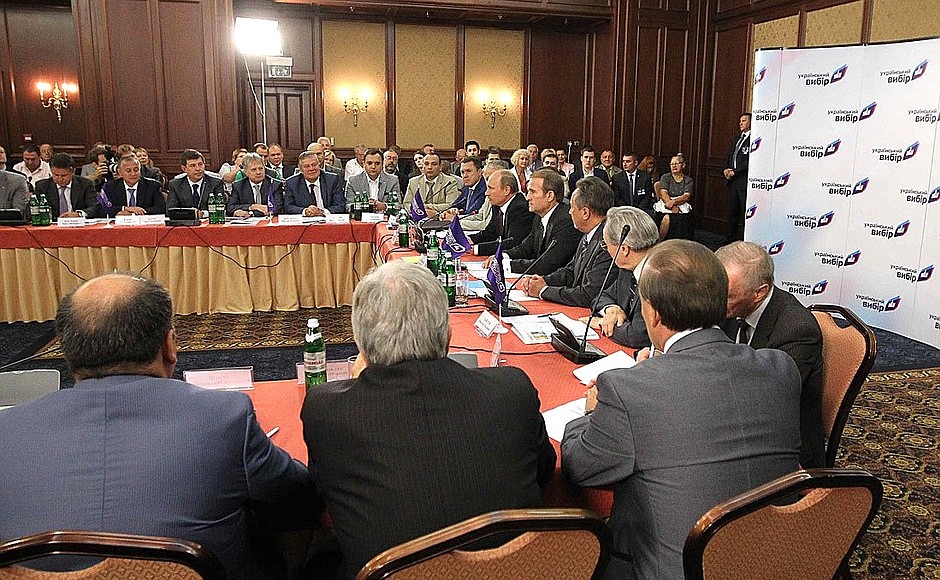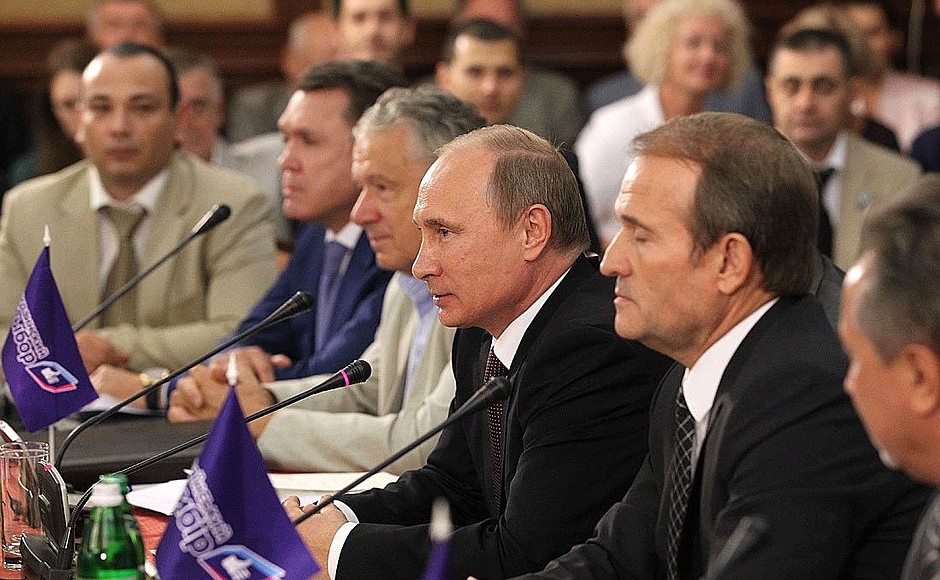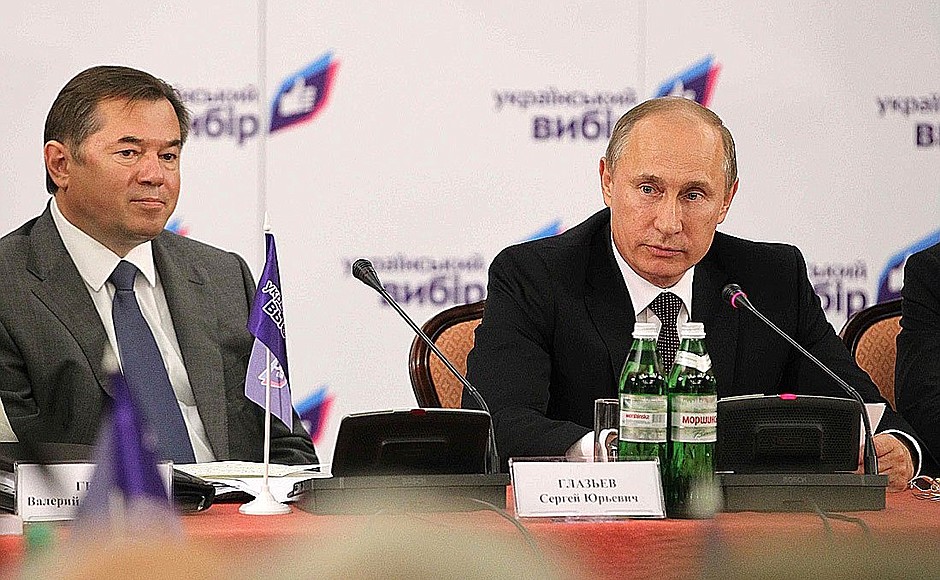President of Russia Vladimir Putin: Good afternoon, friends,
I just said goodbye before to President of Ukraine Mr Yanukovych. You also sent him your best wishes. Unfortunately, he has a strict schedule with a lot of events to attend: meetings with colleagues, with state leaders here for the celebrations of the 1025th anniversary of the Baptism of Rus. As I understand, these circumstances are in large part behind your meeting today.
It is a great pleasure to greet you. As your agenda and your main programme outlines state, you are here to discuss the significance of Ukraine’s civilisational choice. This is not just Ukraine’s civilisational choice. Here at this site, at the baptismal site on the Dnieper River, a choice was made for the whole of Holy Rus, for all of us. Our ancestors who lived in these lands made this choice for our entire people. When I say “for our entire people”, we know today’s reality of course, know that there are the Ukrainian people and the Belarusian people, and other peoples too, and we respect all the parts of this heritage, but at the same time, at the foundations of this heritage are the common spiritual values that make us a single people. The Ukrainian Orthodox Church leaders spoke about this today. It would be hard to deny this. We can only agree with it.
See also
The Baptism of Rus was a great event that defined Russia’s and Ukraine’s spiritual and cultural development for the centuries to come. We must remember this brotherhood and preserve our ancestors’ traditions. Together, they built a unique system of Orthodox values and strengthened themselves in their faith.
Ukraine, like Russia, has not had an easy history. In mediaeval times, Ukraine was part of first one and then another European power centre, came under the rule of one country, then another. But the vision of uniting both the western and eastern parts of Rus, the state that had its beginnings here in Kiev, at this baptismal site on the Dnieper, always lived on in the east and in the west, wherever our people lived. The unity of east and west changed the lives of Ukraine’s population and its elite for the better, as everyone knows. Starting from the 18th century, natives of Kiev and Lviv were prominent in Russia’s science, literary, and church circles.
Before the Russian empress issued a special decree, the decree in effect, as I mentioned earlier at the Kiev Pechersk Lavra, was the Spiritual Regulation issued by Peter the Great in 1721. Bishops’ houses opened theological schools that made an enormous contribution to the Russian people’s education. In accordance with Peter the Great’s decree, the heads of these schools were all from Ukraine. This recognised the common spiritual source that began here. Many Ukrainians were also active in diplomatic and senior civil service in Russia, abroad and in the central government bodies.
After its reunification with Russia, Ukraine developed very rapidly in the 17–18th centuries. It became Russia’s breadbasket. By the end of the 19th century, the Donetsk Basin had become one of Russia’s main mining and metals industry regions, and Odessa was one of the Russian Empire’s biggest seaports.
”The Baptism of Rus was a great event that defined Russia’s and Ukraine’s spiritual and cultural development for the centuries to come. We must remember this brotherhood and preserve our ancestors’ traditions.“
By the late 19th century, Ukraine had a dense railway network. It became one of the big industrial development centres after the reforms of 1861. In just two decades, coal production increased 13-fold, and iron ore production increased by a mighty 158-fold. This was Ukraine’s economic boom. Ukraine produced double the amount of cast iron as the Urals at the end of the 19th century. It was also one of the main centres for transport and agricultural machine-building, producing 30–40 percent of the total national volume of goods in these sectors.
Ukraine’s people played an active part in the Russian Empire’s economic and cultural life. Kiev essentially became the second cultural and scientific capital after St Petersburg. People from Ukraine were very active in developing Siberia. Of the 2.5 million people who resettled in Siberia over 1906–1912, around 1 million came from Ukraine. Today, there are many Ukrainians living in every town and village throughout Siberia.
During the Soviet period, Ukraine had the highest technological and industrial development level of the Soviet republics. It received more than 20 percent of total investment during the first five-year plan. Four hundred of the 1,500 new industrial enterprises created were in Ukraine, including such giants as Zaporozhstal, Kommunar, Krivorozhstal, Azovstal, DneproGES, aluminium smelters, the Kharkov Tractor Factory, and the Lugansk Locomotive Factory. The industrialisation programme put Ukraine ahead of many Western European countries in the heavy industry sector. It was second in Europe after Germany for cast iron production, was in fourth place for coal production, and was ahead of France and Italy and caught up to Britain in the metals and automotive industries. And this was counting only Ukraine on its own!
No effort was spared to rebuild Ukraine after the Great Patriotic War. By 1950, Ukraine was producing more ferrous metals, iron ore, electricity, mineral fertilisers and other important industrial goods than before the war. Gross industrial production was 15 percent higher than the pre-war 1940 figure. It was a whole 44 percent higher in machine-building and metals processing, and 2.3 times higher in production of industrial construction materials. Ukraine’s average annual industrial growth rate was nearly 1.5 times higher than the national average.
Ukraine produced around 48 percent of total Soviet steel output, 33 percent of rolled steel, 53 percent of iron ore, 30 percent of coal, 38 percent of metal-cutting tools, and 71 percent of sugar. It really was an economic and industrial giant. By 1960, industrial output in Ukraine had increased more than 3.6-fold compared to 1940. Labour productivity – an important indicator in any economy, including a market economy – grew by more than 2.5-fold over this period. In 1965, Ukraine’s industrial production was 5.6 times higher than the 1940 level.
Ukraine became a leader in developing advanced technology in the 1970s. You know this better than I. Aircraft-manufacturing, the rocket and space sector, nuclear machine-building, instrument-making industry, shipbuilding, electrical technology – all of it was here. The development levels of sea, rail, and pipeline transport systems were among the highest in the Soviet Union.
”Competition on the global markets is very fierce today. Only by joining forces we can be competitive and stand a chance of winning in this tough environment. We have every reason too, to be confident that we should and can achieve this.“
People’s incomes and living standards increased dramatically over this period. Western estimates show that Ukraine’s per capita income in 1970 was higher than in a developed European country such as Italy.
We all know what happened after the Soviet Union’s collapse. I will not pass any political judgements on those events. We live in different countries today, but this fact in no way crosses out the common historic past that we share, and that is our asset and the foundation upon which we can build new integration ties. We are fortunate to still have a common transport and energy system, a common electricity system, and we have deep-reaching cooperation in many important economic sectors. This cooperation is vital for the effective development of the enterprises involved and indeed of entire economic sectors
Competition on the global markets is very fierce today. I am sure that most of you realise that only by joining forces can we be competitive and stand a chance of winning in this tough environment. We have every reason too, to be confident that we should and can achieve this.
As you know, there are various integration processes underway now in the post-Soviet area. Much has already been said about the depth and benefits of this integration, and I won’t repeat this now. We will respect whatever choice the Ukrainian government and people make on the depth of Ukraine’s engagement in these processes in the post-Soviet area. But there are facts that speak for themselves. Our bilateral trade with Ukraine fell by slightly over 18 percent in the first quarter of this year. Our trade with the Customs Union countries increased by 34 percent in 2011, by 11 percent, I think, in 2012, and was up by 2 or 3 percent in the first quarter of this year, despite the downturn in the global economy. We have steady growth.
Let me say again that we will respect whatever choice our Ukrainian partners, friends and brothers make. The question is only one of how we go about agreeing on working together under absolutely equal, transparent and clear conditions.
I know how hard you are working on searching for the best possible forms of cooperation between Russia and Ukraine. I thank you sincerely for these efforts and wish you success.
Thank you very much.


